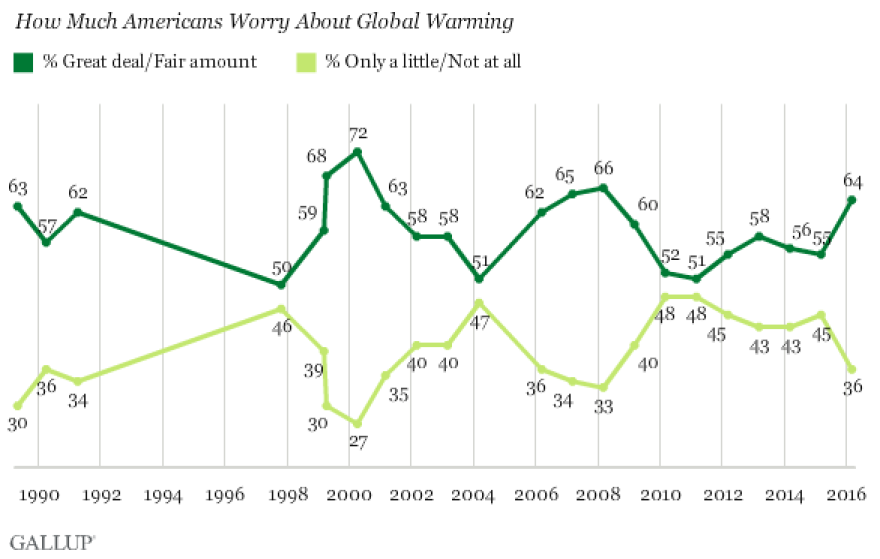Coal-producing states are preparing for arguments next month in the federal appeals court case known as West Virginia v. EPA, challenging the Obama Administration’s Clean Power Plan to limit greenhouse gas emissions from power plants.
The case has major implications for the country’s policy on climate change. But some experts and industry leaders say the outcome is not likely to bring coal back from its decline in the power market.
Diversifying Power
Coal from central Appalachia has been “keeping the lights on” in the U.S. for nearly a century, so perhaps it’s no surprise that West Virginia Attorney General Patrick Morrisey is leading dozens of other states — including Kentucky and Ohio — and many industry groups, in opposition to the new carbon emission standards.
At a May event at the National Press Club in Washington, D.C., Morrisey said the Clean Power Plan disincentivises coal production.
“So if you can reverse some of the regulatory carnage, then there is an opportunity to at least come back,” he said.

But while Morrisey hopes that derailing regulation will help revive an ailing industry, some in that very business say winning or losing the Clean Power Plan won’t significantly affect coal’s fortunes.
“There is a shift going on for reasons beyond the Clean Power Plan,” said Charles Patton, chief operating officer for one of the largest electric utilities in the region, Appalachian Power. Appalachian Power, which serves parts of West Virginia, Virginia, and Tennessee, is a subsidiary of American Electric Power (AEP), the nation’s largest coal-burning utility.
Patton told an energy conference audience at West Virginia University this spring that Appalachian Power’s dependence on coal-generated power will drop from 74 percent in 2012, to 53 percent by 2024.
He pointed to a slide that showed how Appalachian Power plans to diversify its energy portfolio with gas, solar, wind, and battery technology.
“If you would have told me 6 years ago that this would be the slide that I’d have up for you, I wouldn’t have believed you,” Patton said.

Patton said utilities like his are diversifying their energy portfolios as the result of a variety of market forces:
Cheaper, abundant natural gas;
New technology making renewable energy more reliable;
And an overall reduction in demand because of efficiency measures.
Coal’s Outlook Bleak
Coal production in Appalachia has dropped by a third since 2008. West Virginia and Kentucky are seeing some of the lowest coal production rates in decades, and decreases in coal jobs as well. Patton pointed out that at $37/ton, Appalachian coal is the most expensive in the nation – so much so that it must to be mixed with other coal in order to afford to make it an affordable fuel.
The U.S. Energy Information Administration (EIA), a branch of the federal Department of Energy that collects and disseminates data, forecasts that nationally, coal production will further decline by 26 percent between 2015 and 2040. Federal regulators don’t expect the coal market to stabilize until 2021.

EIA analysis indicates the Clean Power Plan will play a negligible role in that decline.
“Coal production in the Appalachian region … is projected to see the smallest reduction in production attributable to the Power Plan,” according to an EIA report.
Like Appalachian Power’s Patton, the EIA points to market forces, not regulations, as the main agent of change. Competition from cheaper natural gas means a historic shift in the nation’s fuel mix for electricity is underway.
EIA predicts 2016 will be the first year on record when natural gas-fired power generation exceeds coal-powered generation.
Beyond The Political Morass
The federal Clean Power Plan aims to stave off the worst predicted impacts of climate change by reducing carbon dioxide emissions by about one-third by 2030. The rule uses state-specific targets to reduce carbon emissions from power plants by 32 percent by 2030 from levels recorded in 2005.
Coal industry leaders argue environmental effects of this rule alone will be insignificant globally. So do some senior advisers at the West Virginia Department of Environmental Protection.
“If you believe that you need to limit carbon emissions across the world in order to avoid those impacts that EPA has projected from climate change,” said Thomas Clarke at West Virginia’s DEP, “you’re not going to do it with this rule.”
Clarke said the Clean Power Plan is an illegal attempt by the EPA to effectively subsidize renewable energy sources and displace fossil fuels in the energy market.

But near record numbers (64 percent) of Americans are now worried about climate change, according to recent Gallup polls. The U.S. and 179 other countries have joined the historic Paris Climate Agreement which commits nations to work to combat climate change. President Obama said the Clean Power Plan is the biggest step the U.S. has taken in that direction.

Columbia School of Law professor Michael Gerrard, who also addressed the WVU energy conference, said that momentum toward binding limits on carbon pollution make engagement in the process a smart move.
“If a state or a region is not at the table, it’s on the menu,” Gerrard said. “And it should participate in the activities leading toward a resolution – not just deny it’s going to happen.”
Patton said old paradigms are being challenged, and his company is reading the carbon writing on the wall.
“Once you get through the political morass,” Patton said, “at the end of the day, most Americans believe that there’s something going on [with the climate] and that we need to take steps to address [climate change]. That belief is common in businesses …and also utilities.”
Oral arguments for and against the Clean Power Plan are slated to be heard in front of the entire D.C. Circuit Court of Appeals in September. Any ruling will most likely be appealed to the Supreme Court in 2017.





